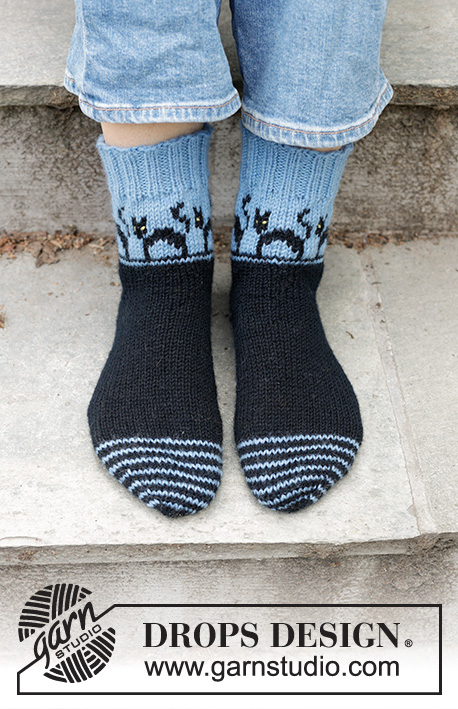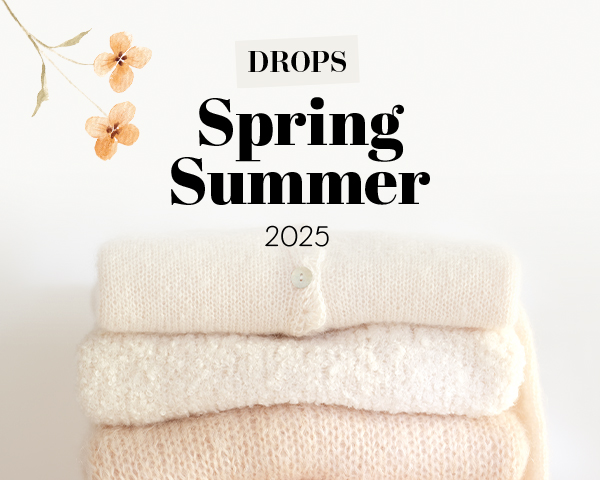Comments / Questions (3)
![]() Liesanne wrote:
Liesanne wrote:
Ik ben er al uit
18.01.2024 - 18:12
![]() Liesanne wrote:
Liesanne wrote:
Brei recht de volgende markeerdraad (bovenkant van de voet). Herhaal van *-* maar brei de nieuwe steek en de volgende steek gedraaid recht samen, brei van *-* tot u alle de overgangen heeft gebreid (tot de andere kant van de hiel), brei recht tot midden onder de voet (markeerdraad). Wat word hier bedoeld met alle overgangen breien? Gewoon alle steken breien over de voet tot aan de andere kant van de hiel? En dan naald 2 gewoon recht over alle steken?
18.01.2024 - 17:49DROPS Design answered:
Dag Liesanne,
Op elke plek waar het werk gekeerd is (voor het maken van de hiel), is een overgang ontstaan en als je die normaal door breit zullen er gaatjes/hiaten ontstaan. Dit kun je oplossen door de draad tussen twee steken op te nemen en deze (gedraaid) samen te breien met de volgende steek. Lees het patroon goed om te kijken of je de steken gedraaid moet breien of niet.
21.01.2024 - 12:14
![]() Sam Lowrie wrote:
Sam Lowrie wrote:
The pattern photo only includes the pictures of the socks, not the pattern. Same situation at 244-44. Thanks!
05.10.2023 - 18:04DROPS Design answered:
Hi Sam, The pattern instructions are to the right and below the photo when you open the page. Happy crafting!
06.10.2023 - 06:42
Spooky Evening Socks#spookyeveningsocks |
||||||||||
 |
 |
|||||||||
Knitted socks in DROPS Karisma. The piece is worked from the toe upwards, with a multicolored pattern with cats and wedge heel. Sizes 35-43 = US 4 ½ - 12 1/2. Theme: Halloween.
DROPS 244-45 |
||||||||||
|
------------------------------------------------------- EXPLANATIONS FOR THE PATTERN: ------------------------------------------------------- STRIPES: * 2 rounds with color black, 1 round with color bright blue *, work from *-* until the piece measures 6-6-7 cm = 2⅜"-2⅜"-2¾" from the cast-on edge. Continue with color black. INCREASE TIP (for toe): Start 2 stitches before the marker, make 1 yarn over, knit 4 (marker sits in the middle of these 4 stitches), make 1 yarn over. Repeat at the other marker = 4 increased stitches on the round. On the next round knit the yarn overs twisted to avoid holes. PATTERN: See diagram A.1. ------------------------------------------------------- START THE PIECE HERE: ------------------------------------------------------- SOCKS - SHORT OVERVIEW OF THE PIECE: The piece is worked in the round with double pointed needles from the toe up. TOE: Cast on 12 stitches with double pointed needles size 3 MM = US 2.5 and color black DROPS Karisma. Divide the stitches, with 3 stitches on each needle. Knit 1 round. Insert 1 marker after the first 3 stitches and 1 marker before the last 3 stitches on the round (6 stitches between the markers and the round begins mid-under the foot). Work stockinette stitch and STRIPES – read description above. AT THE SAME TIME, on the first round increase on each side of both markers – read INCREASE TIP (4 stitches increased). Increase like this every round 2-3-3 times in total, then every 2nd round 6-6-7 times = 44-48-52 stitches. Continue working without further increases until the piece measures 5-5-6 cm = 2"-2"-2⅜" from the cast-on edge. REMEMBER THE KNITTING GAUGE! FOOT: Continue in the round with stockinette stitch until the piece measures 16-17½-18½ cm = 6¼"-6⅞"-7⅛" from the cast-on edge (approx. 6-6½-7½ cm = 2⅜"-2½"-2⅞" left until the foot is finished). WEDGE HEEL: The round begins mid-under the foot. Insert 1 marker here. Insert 1 marker-thread in each side, with 14-16-16 stitches on top of the foot and 30-32-36 heel stitches under the foot. Allow the marker and marker-threads to follow your work onwards. Now work short rows back and forth for the heel, using color black as follows – working 1 stitch less on each row: ROW 1 (right side): Work as far as the first marker-thread. Turn. ROW 2 (wrong side): Slip 1 stitch purl-wise, purl to the 2nd marker-thread, turn. ROW 3 (right side): Slip 1 stitch knit-wise, knit to 1 stitch before the previous turn on the right side, turn. ROW 4 (wrong side): Slip 1 stitch purl-wise, purl to 1 stitch before the previous turn on the wrong side, turn. Repeat rows 3 and 4 until you have 9-10-11 stitches un-worked on one side and 8-9-10 stitches un-worked on the other side; 13-13-15 stitches in the middle of the row and the last row worked from the wrong side, turn. Work as follows from the right side: Slip 1 stitch knit-wise, knit to the marker under the foot. The short rows are finished. Now work 2 rounds over all stitches as follows: ROUND 1: To avoid a hole in the transition between stitches, knit to where you turned on the last row from the right side, * use the left needle and pick up the strand between the stitches on the left and right needle (1 new stitch), knit together the new stitch and the next stitch *, repeat from *-* to the first marker-thread (one side of the heel). Knit to the next marker-thread (top of foot). Repeat from *-* but knit the new stitch and the next stitch twisted together, work from *-* until you have worked all the transitions (to the other side of the heel), knit to mid under the foot (marker). ROUND 2: Knit. Move the marker-threads so they are on each side of the middle 12-12-14 stitches mid-under the foot. Now work short rows again as follows – working 1 more stitch on each row: ROW 1 (right side): Knit as far as the first marker-thread, turn. ROW 2 (wrong side): Slip 1 stitch purl-wise, purl to the second marker-thread, turn. ROW 3 (right side): Slip 1 stitch knit-wise, knit to where you turned the previous time from the right side, use the left needle and pick up the strand between the stitches on the left and right needle (1 new stitch), knit together the new stitch and the next stitch, turn. ROW 4 (wrong side): Slip 1 stitch purl-wise, purl to where you turned previously on the wrong side, use the left needle and pick up the strand between the stitches on the left and right needle (1 new stitch), purl twisted together the new stitch and the next stitch, turn. Repeat rows 3 and 4 until there is 1 stitch left before the marker-thread on each side and the last row was from the wrong side, turn. Work the next round as follows: Knit over all stitches, closing the holes in each transition in the same way as before. Insert 1 marker. The leg is measured from here! LEG: = 44-48-52 stitches. The beginning of the round is mid-back of heel. Work stockinette stitch in the round with color black until the leg measures 3 cm = 1⅛" from the marker. Knit 1 round and increase 11-7-14 stitches evenly spaced = 55-55-66 stitches. Work diagram A.1, 5-5-6 times on the round. When A.1 is finished, continue with color bright blue. Work until the leg measures 8 cm = 3⅛" from the marker (make sure you have at least 3 rounds of bright blue after the last black stitch in the diagram). Knit 1 round and adjust the stitch count to 52-56-68 stitches. Change to double pointed needles size 2.5 MM = US 1.5. Work rib (knit 2, purl 2) for 4 cm = 1½". Bind off with rib. ASSEMBLY: Fold the toe, with 6 stitches both on top of and underneath the foot. Sew the cast-on edges together, it is neatest to use grafting stitch. Fasten the strand well. EMBROIDERING: Use a left-over color yellow and embroider 2 small flat stitches for the eyes on each cat - see diagram B. |
||||||||||
Diagram explanations |
||||||||||
|
||||||||||

|
||||||||||

|
||||||||||
Have you finished this pattern?Tag your pictures with #dropspattern #spookyeveningsocks or submit them to the #dropsfan gallery. Do you need help with this pattern?You'll find 22 tutorial videos, a Comments/Questions area and more by visiting the pattern on garnstudio.com. © 1982-2025 DROPS Design A/S. We reserve all rights. This document, including all its sub-sections, has copyrights. Read more about what you can do with our patterns at the bottom of each pattern on our site. |
||||||||||



































































Post a comment to pattern DROPS 244-45
We would love to hear what you have to say about this pattern!
If you want to leave a question, please make sure you select the correct category in the form below, to speed up the answering process. Required fields are marked *.